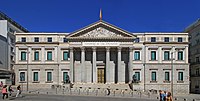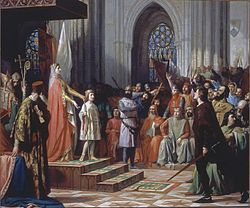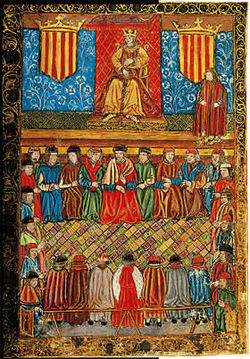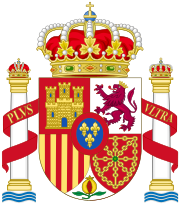Cortes Generales
General Courts | |
|---|---|
Government (147)
Supported by (32) Opposition (171) | |
| Elections | |
 | |
| Congress of Deputies Palacio de las Cortes Carrera de San Jerónimo Centro, Madrid | |
| Website | |
| cortesgenerales | |
The Cortes Generales (Spanish pronunciation: [ˈkoɾtes xeneˈɾales]; English: Spanish Parliament, lit. 'General Courts') are the bicameral legislative chambers of Spain, consisting of the Congress of Deputies (the lower house) and the Senate (the upper house).
The Congress of Deputies meets in the Palacio de las Cortes. The Senate meets in the Palacio del Senado. Both are in Madrid. The Cortes are elected through universal, free, equal, direct and secret suffrage,[1] with the exception of some senatorial seats, which are elected indirectly by the legislatures of the autonomous communities. The Cortes Generales are composed of 615 members: 350 Deputies and 265 Senators.
The members of the Cortes Generales serve four-year terms, and they are representatives of the Spanish people.[2] In both chambers, the seats are divided by constituencies that correspond with the fifty provinces of Spain, plus Ceuta and Melilla. However, each island or group of islands within the Canary and Balearic archipelagos forms a different constituency in the Senate.[3]
As a
The modern Cortes Generales were created by the 1978 Constitution of Spain, but the institution has a long history.
History
This section needs additional citations for verification. (December 2020) |
Visigothic Kingdom
The
High Middle Ages (8th–12th centuries)
The
Rise of the bourgeoisie (12th–15th centuries)

During the
Habsburg rule (16th–17th centuries)


Beginning with the
Reorganized, the corteses retained some power over the realm's finances—particularly in Aragon—but became limited to a consultative entity. By the reign of Philip II, the delegates of the Cortes of Castile were financially dependent on the Crown for their income.[6] The Imperial Cortes and its deputation (Spanish: Diputación General de Cortes) primarily concerned themselves with overseeing previous agreements and the collection of taxes in Castile and the larger empire; separate deputations oversaw similar work in Aragon and Navarre.[7]
The corteses were able to regain some of their previous powers and influence during the 17th century, as repeated sovereign defaults reduced the monarchy to financial dependency and a series of deputies including the Count-Duke of Olivares oversaw most day-to-day government. Under the young and chronically ill Charles II, the Cortes of Castile was responsible for naming his mother Mariana regent.
Bourbon rule (18th–19th centuries)
During the
Napoleonic Spain and the Three Liberal Years

With both the Bourbon monarchs
First Spanish Republic (1873–1874)
When the monarchy was overthrown in 1873, the king was forced into exile. The
Restoration (1874–1930)
The regime just after the First Republic is called the
Soon after the
Second Spanish Republic (1931–1939)
The dictatorship, now ruled by Admiral Aznar-Cabañas, called for local elections. The results were overwhelmingly favorable to the monarchist cause nationally, but most provincial capitals and other sizable cities sided heavily with the republicans. This was interpreted as a victory, as the rural results were under the always-present suspicion of caciquismo and other irregularities while the urban results were harder to influence. The King left Spain, and a Republic was declared on 14 April 1931.
The Second Spanish Republic was established as a
The first term was the constituent term charged with creating the new
The elections for the second term
The next election was held in 1936. It was hotly contested, with all parties converging into three coalitions: the leftist Popular Front, the right-winged National Front and a Centre coalition. In the end, the Popular Front won with a small edge in votes over the runner-up National Front, but achieved a solid majority due to the new electoral system introduced by the CEDA government hoping that they would get the edge in votes. The new Parliament then dismissed Alcalá-Zamora and installed Manuel Azaña in his place. During the third term, the extreme polarisation of the Spanish society was more evident than ever in Parliament, with confrontation reaching the level of death threats. The already bad political and social climate created by the long-term left-right confrontation worsened, and many right-wing rebellions were started. Then, in 1936, the Army's failed coup degenerated into the Spanish Civil War, putting an end to the Second Republic.
From November 1936 to October 1937, the Cortes were held at Valencia City Hall, which was still being used for its local purposes at the same time. The building was a target for the Italian Air Force in service of the Nationalist faction, resulting in a bombing in May 1937.[9]
Francoist Spain (1943–1977)
Cortes Generales under the Constitution of 1978


The Cortes are a bicameral parliament composed of a lower house (
The Congress is composed of 350 deputies (but that figure may change in the future as the constitution establishes a maximum of 400 and a minimum of 300) directly elected by universal suffrage approximately every four years.
The Senate is partly directly elected in that four senators per province are elected as a general rule and partly appointed by the legislative assemblies of the
Joint Committees
| Committee | Office | Chair(s) | Term | Refs |
|---|---|---|---|---|
| Relations with the Court of Auditors | deputy | Santos Cerdán León ( PSOE )
|
2020–present | [13] |
| European Union | deputy | Susana Sumelzo Jordán (PSOE) | 2020–present | [14] |
| Relations with the Ombudsman | deputy | Vicente Tirado Ochoa (PP) | 2020–present | [15] |
| Parliamentary Control of RTVE's Board and its Partnerships | senator | Antonio José Cosculluela Bergua (PSOE) | 2020–present | [16] |
| National Security | deputy | Carlos Aragonés Mendiguchía (PP) | 2020–present | [17] |
| Study of Addictions' Issues | deputy | Francesc Xavier Eritja Ciuró (ERC) | 2020–present | [18] |
| Coordination and Monitoring of the Spanish Strategy to accomplish the Sustainable Development Goals (SDGs) | deputy | Joan Mena Arca (ECP) | 2020 | [19] |
| deputy | Aina Vidal Saéz (ECP) | 2020–present |
See also
 |
|---|
- List of presidents of the Congress of Deputies of Spain
- Solemn Opening of the Parliament of Spain
- Bureaus of the Cortes Generales
- Spanish Parliamentarism
Notes
References
- ^ Article 68.1 and 69.1 of the Constitution of Spain (1978)
- ^ Article 66 of the Constitution of Spain (1978)
- ^ Article 69.3 of the Constitution of Spain (1978)
- ^ Scott, Samuel Parsons, ed. (1910), The Visigothic Code (Forum Judicum), Boston, MA: Boston Book Co., pp. ix–xxi
- ^ Keane, John (2009), The Life and Death of Democracy, London: Simon & Schuster.
- ISBN 0-299-08500-7
- ISBN 8420620408.
- OCLC 3315063.
- ^ "Cuando el Ayuntamiento de Valencia fue bombardeado" [When Valencia City Hall was bombed]. El País (in Spanish). 30 May 2017. Retrieved 12 October 2022.
- ^ Giménez Martínez 2015, pp. 71–72.
- ISSN 0214-4212.
- ^ Giménez Martínez 2015, p. 75.
- ^ "Current membership of Comisión Mixta para las Relaciones con el Tribunal de Cuentas". Congreso de los Diputados. Archived from the original on 11 September 2021. Retrieved 11 September 2021.
- ^ "Current membership of Comisión Mixta para la Unión Europea". Congreso de los Diputados. Archived from the original on 11 September 2021. Retrieved 11 September 2019.
- ^ "Current membership of Comisión Mixta de Relaciones con el Defensor del Pueblo". Congreso de los Diputados. Archived from the original on 11 September 2021. Retrieved 11 September 2021.
- ^ "Current membership of Comisión Mixta de Control Parlamentario de la Corporación RTVE y sus Sociedades". Congreso de los Diputados. Archived from the original on 11 September 2021. Retrieved 11 September 2021.
- ^ "Current membership of Comisión Mixta de Seguridad Nacional". Congreso de los Diputados. Archived from the original on 11 September 2021. Retrieved 11 September 2021.
- ^ "Current membership of Comisión Mixta para el Estudio de los Problemas de las Adicciones". Congreso de los Diputados. Archived from the original on 11 September 2021. Retrieved 11 September 2021.
- ^ "Current membership of Comisión Mixta para la Coordinación y Seguimiento de la Estrategia Española para alcanzar los Objetivos de Desarrollo Sostenible (ODS)". Congreso de los Diputados. Archived from the original on 11 September 2021. Retrieved 11 September 2021.
Further reading
- O’Callaghan, Joseph F. The Cortes of Castile-León, 1188–1350, 1989.
- Constitución Española, Título III, De las Cortes Generales, 1978
